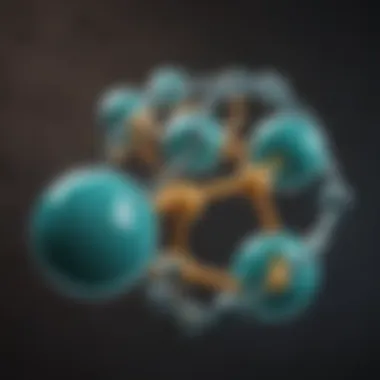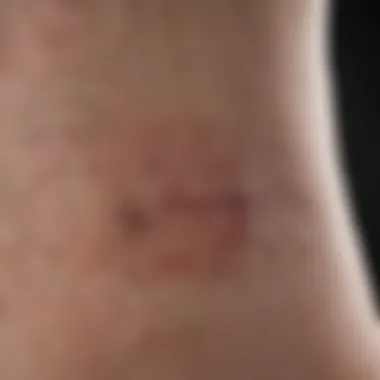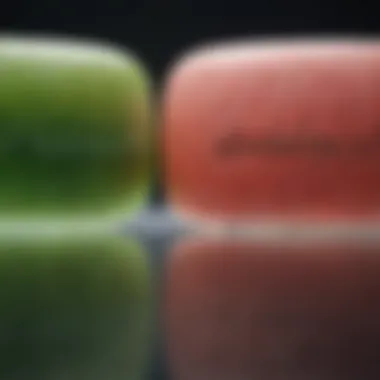Role of Hypochlorous Acid in Wound Management


Research Background
Wound care is an essential aspect of modern medicine, with its effectiveness directly influencing patient outcomes. Historically, the treatment of wounds has evolved from traditional methods using natural substances to sophisticated antiseptics. One promising substance in recent times is hypochlorous acid. This compound is not just a synthetic gimmick; it’s found naturally in the human body's immune system. The introduction of hypochlorous acid into wound management is a significant step towards enhancing healing processes.
Overview of the scientific problem addressed
Wounds can become easily infected due to various pathogens present in the environment. The challenge has always been finding a balance between effective antimicrobial action and safety for the surrounding tissue. Conventional antiseptics, while effective, often come with a price—their harshness can delay wound healing or even damage healthy cells. A pressing concern in the medical community is whether there exists an option that can provide robust antimicrobial protection while also being gentle enough for tissue repair.
Historical context and previous studies
In the late 19th century, the foundation for antiseptic use in surgery and wound management was laid, with substances like carbolic acid becoming the first widely adopted disinfectants. As the centuries rolled on, researchers began to explore alternatives that would minimize tissue damage. In the last couple of decades, studies have illuminated hypochlorous acid’s unique characteristics, showing its potential to reduce bioburden without causing harm to the human cells. Noteworthy findings indicated that wounds treated with hypochlorous acid demonstrated improved healing rates and less inflammation compared to traditional antiseptics. As the scientific community gathers more evidence, it becomes imperative to paint a clearer picture of its clinical applications.
Findings and Discussion
The findings surrounding hypochlorous acid are as interesting as the compound itself. Numerous studies point to its efficacy against a broad spectrum of pathogens, including bacteria, fungi, and viruses, which proves it effective in managing contaminated wounds.
Key results of the research
- Antimicrobial Efficacy: Investigations have shown that hypochlorous acid can kill pathogens like Staphylococcus aureus and Pseudomonas aeruginosa effectively.
- Safety Profile: Research highlighted its low toxicity towards human cells, suggesting a minimal inflammatory response. Patients experienced fewer side effects compared to traditional remedies.
- Enhanced Healing: In clinical trials, patients treated with hypochlorous acid had observable improvements in the rate of tissue regeneration compared to those who received conventional treatments.
Interpretation of the findings
The results portray hypochlorous acid as a game changer in wound care. Given its impressive track record in clinical settings, it paves the way for more integrative and effective wound management protocols. The dual ability to combat infection and promote healing can drastically change standard practices in hospitals and clinics. As the body of evidence expands, its role across different wound types—from surgical to chronic ulcers—becomes clearer.
Preamble to Hypochlorous Acid
Understanding hypochlorous acid is akin to uncovering a hidden gem in the realm of wound care. This compound, although possibly not well-known to the average person, is playing a pivotal role in modern medical practices. It serves not only as a means of disinfection but also as a facilitator of healing processes, thanks to its unique properties. In this section, we explore the importance of hypochlorous acid, focusing on its definition, chemical properties, and historical contexts that carry significant implications for its use in clinical settings.
Definition and Chemical Properties
Hypochlorous acid is a weak acid, formed when chlorine dissolves in water. Its chemical formula is HOCl, and it exists in equilibrium with its anions, hypochlorite ions (OCl−). In terms of its molecular structure, it consists of a chlorine atom bonded to a hydroxyl group, making it a unique substance with potent antimicrobial effects. One key characteristic of hypochlorous acid is its ability to penetrate bacterial cell walls, quickly disrupting their internal functions and rendering them ineffective.
This property makes it a prime candidate for application in wound care, as it can assist in preventing infections, reducing inflammation, and promoting a conducive healing environment for tissue repair. Furthermore, hypochlorous acid's stability and efficacy at physiological pH levels make it less likely to irritate surrounding healthy tissues, which is an important consideration in wound management.
Historical Context of Its Use
The usage of hypochlorous acid can be traced back to the late 19th century, particularly during the time when Joseph Lister was advocating for antiseptic surgical practices. Despite advancements in wound care technology over the years, many healthcare practices have drawn upon the principles established by Lister. This laid the groundwork for using compounds like hypochlorous acid, particularly as it was known that the human immune system produces hypochlorous acid naturally as a defense mechanism against infections.
As an example, during World War I, hypochlorous acid was utilized in field hospitals to treat infected wounds, showcasing its effectiveness even in challenging conditions. During its application, many physicians observed its efficiency in promoting healing and reducing the incidence of further complications.
Today, with emerging research highlighting the benefits of hypochlorous acid in studies and clinical settings, there's a renewed interest in its application. As we dig deeper into its role in wound care, understanding its historical significance ensures we are not just reinventing the wheel but rather building upon a foundation that has proven to be beneficial.
"Hypochlorous acid's role in wound care is not merely functional; it embodies a continuity of practice that bridges traditional medicine with modern advancements."
The exploratory journey of hypochlorous acid continues to unfold, and with each layer we peel back, its relevance only seems to solidify. In subsequent sections, we will analyze its mechanisms of action, the broad spectrum of its antimicrobial activity, and its compatibility with human tissues, ultimately showcasing why it deserves a significant place in wound care strategies.
Role in Wound Care


In the realm of wound care, hypochlorous acid is steadily carving out its niche thanks to its distinctive properties and capabilities. Its inclusion in modern therapeutic practices is not merely a trend; it springs from rigorous studies that highlight its advantages in treating various wound types. As clinicians and researchers alike seek effective solutions, knowing how hypochlorous acid contributes can be key to improving patient outcomes and overall wound management strategies.
Mechanism of Action
Understanding the mechanism of action of hypochlorous acid is essential to grasping its significance in wound care. This compound works mainly by aiding the body's natural immune response. When hypochlorous acid comes into contact with pathogens, it penetrates their outer membranes, leading to disruption and eventual death. This process hinges on its ability to react with proteins and nucleic acids within microbial cells, which can ultimately halt their growth.
- Reactive Species: Hypochlorous acid generates reactive species that exhibit potent antimicrobial effects while being predominantly unfriendly to pathogens.
- pH Dependence: One remarkable factor about hypochlorous acid is its efficacy across various pH levels, making it adaptable for different wound environments. This adaptability is crucial since wound exudate can change the pH around the injury site, potentially affecting other treatments.
- Dual Action: While its primary role is to eliminate unwanted microbes, hypochlorous acid also has anti-inflammatory properties that can aid in wound healing. This duality fosters an environment conducive to tissue repair, often leading to better recovery times for patients.
In essence, hypochlorous acid does not just act against infections; it engages the body's healing processes, akin to adding a gentle nudge to get things moving in the right direction.
Broad-Spectrum Antimicrobial Activity
The broad-spectrum antimicrobial activity of hypochlorous acid sets it apart from many conventional antiseptics. Unlike common antiseptic solutions that may target specific types of pathogens, hypochlorous acid boasts a wider reach. It effectively combats a diverse array of microorganisms, including:
- Bacteria: Particularly resistant strains like MRSA.
- Viruses: Including many that cause infections in the skin.
- Fungi: Such as those responsible for athlete's foot or other dermal fungal infections.
This extensive spectrum is crucial for wound care, where polymicrobial infections are common, particularly in chronic wounds. A treatment that can disrupt multiple types of pathogens at once reduces the chances of an infection spreading and complicating the recovery process. Moreover, studies suggest that regular use of hypochlorous acid can decrease the need for systemic antibiotics, reducing the risk of developing antibiotic-resistant strains.
Tissue Compatibility
One of the standout features of hypochlorous acid is its compatibility with human tissue. Unlike harsher antiseptic solutions that can cause irritation or damage to healthy cells, hypochlorous acid is gentle. It mimics the natural components of human immune responses, which is vital when treating open wounds. Key points regarding its tissue compatibility include:
- Non-cytotoxic: It can be applied to wounds without harming surrounding healthy tissues, a critical consideration in wound management.
- Promotes Healing: By minimizing cellular damage and inflammation, hypochlorous acid supports faster wound closure and regeneration of skin.
- Easy Application: Available in various forms including sprays, gels, and wipes, which provide versatility depending on injury depth and severity.
"Utilizing hypochlorous acid not only fights infection but creates a friendly environment for the healing process to take place more effectively."
In sum, hypochlorous acid stands out in wound care not just for its effectiveness against pathogens but also its harmonious relationship with the tissues it's designed to protect and heal. This balance is essential for health professionals when devising treatment plans tailored to the needs of their patients.
Comparative Analysis with Traditional Antiseptics
The role of hypochlorous acid as a wound care agent necessitates a thoughtful consideration of its efficacy and safety compared to traditional antiseptics. Traditional antiseptics often include substances such as chlorhexidine, iodine, and alcohol. While these agents have long been used for infection control, their limitations can be significant. Comparatively analyzing hypochlorous acid against these conventional choices is essential for identifying its advantages and understanding its practical application in clinical settings.
Efficacy Against Pathogens
When it comes to killing germs, hypochlorous acid holds a strong card. It effectively tackles a wide range of pathogens, including bacteria, viruses, and fungi. Studies show that hypochlorous acid operates efficiently within the pH range that resembles bodily fluids, optimizing its action when applied to wounds. Traditional antiseptics, such as iodine-based solutions, can be potent but may also have a higher risk of causing tissue irritation. Hypochlorous acid, on the other hand, boasts a lower irritation profile — this is crucial when dealing with sensitive tissues in wound management.
For instance, research indicates that while a common antiseptic like hydrogen peroxide can cause damage to healthy tissues, hypochlorous acid tends to promote healing by maintaining the balance of the wound microenvironment. This capacity to kill pathogens without harming the surrounding tissue may play a significant role in faster recovery times.
Safety and Toxicity Profiles
Safety is paramount in wound care, especially for patients with compromised health. Traditional antiseptics often come with side effects, such as stinging or allergic reactions, which can complicate the healing process. Hypochlorous acid, deriving from the human body's own immune response, exhibits a remarkable safety profile. It is well-tolerated and has minimal risk of cytotoxicity.
The differences in toxicity can be stark. For example, when compared to alcohol, which can lead to dryness and irritation, hypochlorous acid maintains moisture and supports tissue integrity. This aspect is especially beneficial during the healing stage when the maintenance of a moist wound environment is crucial. In summary, it's not just about killing pathogens; it’s also about doing so without compromising patient safety.
User Experience and Application Techniques
The user experience can significantly affect the acceptance of a wound care product. Hypochlorous acid can be applied easily in clinical and home environments, often available in spray or irrigation solutions. One significant advantage over traditional methods, like iodine solutions, is that hypochlorous acid does not stain or leave an unpleasant residue, making it more patient-friendly.
Moreover, the non-toxic nature allows for frequent applications. Using it multiple times a day can be facilitated without the fear of harming the healing tissue, a common concern with traditional antiseptics that require more caution in application.


In clinical practice, providers have found hypochlorous acid particularly useful for various wound types, including chronic wounds, burns, and surgical incisions. Educating both patients and health care professionals on proper techniques—such as using gentle, sweeping motions when applying a spray—enhances effectiveness while minimizing discomfort.
"Hypochlorous acid offers a gentle yet effective approach to wound care, balancing efficacy with safety."
Clinical Applications and Case Studies
The clinical applications of hypochlorous acid in wound care offer a unique viewpoint on its practical utility and effectiveness. Understanding how this agent is applied in various scenarios not only broadens the scope of our knowledge but also highlights its value in real-world settings. Hypochlorous acid stands out in this context due to its remarkable antimicrobial properties, low toxicity, and versatility in treating diverse types of wounds. Each application presents unique challenges and considerations, forming a comprehensive picture of its role in modern medicine.
Chronic Wound Management
Chronic wounds, such as diabetic ulcers, venous ulcers, and pressure sores, are notoriously difficult to treat and can lead to significant patient discomfort and healthcare costs. In these cases, hypochlorous acid can be a game changer. Its ability to destroy pathogens while promoting a conducive healing environment makes it particularly suitable for such challenging wounds.
The application of hypochlorous acid in chronic wound management encourages a more effective healing process by:
- Reducing biofilm formation: Biofilms are a common obstacle in chronic wound healing, providing a protective barrier for bacteria. Hypochlorous acid effectively disrupts these biofilms, allowing for better penetration of other treatments.
- Promoting granulation tissue formation: By maintaining a moist wound environment and enhancing cellular activity, hypochlorous acid supports the growth of new tissue, speeding up the healing process.
- Minimizing inflammation: Chronic inflammation can further exacerbate wound healing. The anti-inflammatory properties of hypochlorous acid help mitigate this response, fostering a more balanced healing environment.
Research indicates that patients using hypochlorous acid in their treatment regimen often exhibit improved outcomes compared to traditional methods, making it a critical tool for clinicians managing chronic wounds.
Post-Surgical Wound Care
After surgical procedures, proper wound care is paramount to prevent infections and ensure successful recovery. Here, hypochlorous acid shines as an adjunct to standard care protocols. Its application brings forth several key advantages:
- Enhanced antimicrobial effect: Post-surgical wounds are at high risk for infections, especially in the first few days. Using hypochlorous acid as a rinse or spray can dramatically reduce microbial load on the wound, potentially minimizing complications.
- User-friendly application: The non-toxic and safe nature of hypochlorous acid means it can be applied easily by patients or caregivers, reducing the burden on healthcare professionals while ensuring consistent wound care.
- Odor neutralization: Many surgical wounds produce unpleasant odors due to infection or necrosis. Hypochlorous acid can effectively neutralize these odors, improving patient comfort and satisfaction.
With ongoing studies further illustrating its effectiveness, hypochlorous acid is becoming a staple in post-surgical care protocols across various medical settings.
Burn Treatment
Burn injuries present a unique set of challenges in wound management, requiring treatments that address both the risk of infection and the pain associated with care. The use of hypochlorous acid in burn treatment is gaining traction for several reasons:
- Pain reduction: Patients often experience significant discomfort during wound cleaning. The gentle nature of hypochlorous acid minimizes stinging and irritation, making dressing changes more tolerable.
- Support for healing: Hypochlorous acid not only helps to keep the area clean but also fosters a favorable environment for epithelialization, which is critical in burn recovery.
- Prevention of hypertrophic scars: The use of hypochlorous acid has been associated with decreased incidence of hypertrophic scarring in burn patients, which is a significant concern for many survivors.
Thus, integrating hypochlorous acid into burn care protocols can have far-reaching effects on both the physical healing process and the overall quality of life for burn patients.
"Hypochlorous acid exemplifies the perfect blend of efficacy and safety, marking its territory in diverse clinical settings."
Through diverse clinical applications and evolving case studies, hypochlorous acid continues to assert its position as a vital player in wound management, promising not only improved outcomes but also enhanced patient experiences.
Regulatory and Manufacturing Considerations
When exploring the role of hypochlorous acid in wound care, the regulatory and manufacturing landscape is of significant importance. This aspect ensures that the products utilizing hypochlorous acid not only meet legal requirements but also maintain a high standard of safety and effectiveness. The relevance of regulatory oversight is particularly pronounced when considering the increasing interest in antiseptics that promise both efficacy and safety.
The manufacturing process of hypochlorous acid products involves several crucial stages where compliance with regulations is non-negotiable. Issued by health authorities, these regulations serve to protect users while fostering innovation within the industry.
Standards for Medical Use
Medical standards for hypochlorous acid focus largely on its formulation, concentration, and intended use. In many jurisdictions, products must adhere to guidelines established by organizations such as the U.S. Food and Drug Administration (FDA) or the European Medicines Agency (EMA). These standards aim to ensure that hypochlorous acid products are safe for application, particularly considering their widespread use in healing wounds. Products marketed for clinical use typically undergo rigorous testing to ascertain their microbiological quality and ensure sterility.


Approvals often hinge on exhaustive studies demonstrating safety profiles that minimize risks while maximizing benefits. Labeling also falls under these regulations, mandating clear instructions and necessary warnings to guide practitioners in safe application. This level of scrutiny helps to build trust in hypochlorous acid as a reliable component in wound care.
Quality Control in Production
Quality control represents another pillar in the regulatory framework concerning hypochlorous acid. Manufacturers are required to implement quality management systems that conform to established guidelines. This may include routine batch testing to ensure consistency in product formulation and safety.
Key aspects of quality control include:
- Raw material sourcing: Ensuring that components meet purity levels and are free from contaminants.
- Process validation: Continuous monitoring of production processes to ensure that they align with established protocols.
- Final product testing: Comprehensive analyses before products reach the market, looking closely at potency, sterility, and overall quality.
Establishing these quality control measures not only helps manufacturers comply with legal requirements, but it also enhances their reputation in the market. It ensures healthcare providers and patients alike can rely on the products being used for wound care, reinforcing the notion that hypochlorous acid is a safe option for treatment.
In summary, the intersection of regulatory and manufacturing considerations plays a pivotal role in the integration of hypochlorous acid into wound care. The adherence to stringent standards and robust quality control processes serves to bolster confidence in this promising therapeutic agent.
Potential for Future Research
The exploration of hypochlorous acid in various healthcare contexts signals a burgeoning field ripe for deeper scholarly inquiry. While its role in wound care is increasingly recognized for its efficacy and safety, potential research avenues remain underexplored. This section aims to illuminate those possibilities and underscore the importance of further investigation in optimizing and diversifying the applicability of hypochlorous acid.
Innovative Formulations
Recent advancements in pharmaceutical technology have opened doors to innovative formulations of hypochlorous acid. These improvements are pivotal not just for enhancing stability and shelf life but also for refashioning its application methods. Imagine creating micro-encapsulated formulations that could release hypochlorous acid in a controlled manner over time—this could lead to prolonged antimicrobial effects without compromising safety.
Moreover, pH-balanced gels and aerosol sprays can be purposefully designed for various wound care scenarios. While liquid forms are effective, the future may hold the promise of more user-friendly applications tailored to specific patient needs. The move to new formats can directly address challenges faced in consistent patient use, thus enhancing compliance with wound care regimens.
Research into bioactive combinations using plant extracts, for example, might yield synergistic effects with hypochlorous acid to foster healing. By delving into the interplay of natural compounds and hypochlorous acid, researchers stand to innovate formulations that not only disinfect but also aid in tissue regeneration.
"The potential for hypochlorous acid to work in concert with other natural healing agents can redefine our approach to wound management."
This synergy is not a far-fetched concept, but a potential reality as science moves forward.
Applications Beyond Wound Care
While this article primarily addresses hypochlorous acid's impact in wound management, its applications extend far beyond. Exploring its versatility opens exciting pathways for research.
- Oral Health: Hypochlorous acid is garnering interest in the field of oral hygiene. Its antimicrobial properties could revolutionize treatments for conditions like gingivitis, enabling better patient management in dental health.
- Skin Care: The beauty industry might also benefit significantly from hypochlorous acid, especially in formulations aimed at acne treatment or as an anti-inflammatory agent. Its gentle yet effective nature could capture the interest of users seeking alternatives to harsh chemicals.
- Industrial Applications: Beyond personal care, there’s room for research into using hypochlorous acid as an industrial disinfectant. Its ability to eliminate pathogens without harmful residues can enhance sanitation protocols in food processing and public health environments.
- Environmental Disinfectants: With growing concerns over chemical residues, there’s potential for eco-friendly cleaning solutions featuring hypochlorous acid, which can effectively kill bacteria while posing minimal environmental risks.
As researchers broaden the scope of hypochlorous acid applications, we can expect to discover its untapped potential across numerous sectors, each offering unique benefits and implications. Ensuring a multidisciplinary approach will be key to comprehensively understanding how hypochlorous acid can be utilized in fields beyond its immediate therapeutic context.
Finale and Implications
In wrapping up our exploration of hypochlorous acid in wound care, it's essential to underscore its significance and the crucial implications for medical practice. The incorporation of hypochlorous acid stands not just as a novel trend but as a necessity that addresses the rising concerns of antibiotic resistance and the quest for safer wound management solutions. Its effectiveness against a wide range of pathogens combined with its biocompatibility presents a valuable option for both clinicians and patients.
Summary of Findings
Through our thorough analysis, we’ve observed several key points regarding hypochlorous acid:
- Antimicrobial Efficacy: Hypochlorous acid offers a powerful defense against bacteria, viruses, and fungi, making it a formidable agent in the fight against infections in wounds.
- Tissue Compatibility: It does not harm human cells, which is a significant advantage over traditional antiseptics, reducing the risk of further complications in wound healing.
- Application Versatility: Hypochlorous acid can be used in various wound care scenarios, from chronic wounds to post-surgical applications, providing a flexible approach to treatment.
"The adaptability of hypochlorous acid in different clinical contexts underscores its potential as a cornerstone in modern wound management strategies."
Recommendations for Practice
As we navigate the future of wound care, it is prudent for practitioners to consider the following recommendations:
- Integration into Protocols: Healthcare providers should incorporate hypochlorous acid into existing wound care protocols to maximize patient outcomes, particularly in cases resistant to standard treatments.
- Training and Education: Ensuring staff are well-informed about the properties and benefits of hypochlorous acid can foster greater acceptance and application in clinical settings.
- Continued Research: Ongoing studies to further elucidate its properties and expand its applications can pave the way for hypochlorous acid to become a mainstay in the medical toolkit. Investigating innovative formulations could lead to even broader uses.
- Patient Education: Informing patients about the benefits and safety of hypochlorous acid will help demystify its use and enhance compliance.







